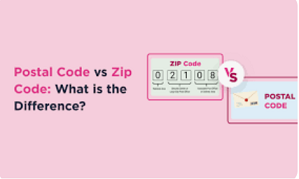Postal Codes: When it comes to mailing letters or shipping packages, both Canada and the United States use unique systems to identify specific regions and ensure accurate delivery. In Canada, this system is known as the postal code, whereas in the United States, it is referred to as the ZIP code. Although they serve the same purpose—directing mail to the correct destination—there are important differences between the two systems. Understanding these distinctions can be helpful for individuals, businesses, and international shippers.
Structure and Format For Postal Codes
The most obvious difference between Canadian postal codes and U.S. ZIP codes lies in their structure.
- Canadian Postal Codes: These codes are alphanumeric and follow a specific pattern of “Letter-Digit-Letter Digit-Letter-Digit” (e.g., M5V 3L9). The letters generally represent geographic areas, while the numbers further narrow down the location to a specific neighborhood, block, or even a single building in some cases. This high level of precision makes Canadian postal codes more detailed.
- U.S. ZIP Codes: ZIP codes are purely numeric and usually consist of five digits (e.g., 90210). In some cases, an extended ZIP+4 code is used, which adds a hyphen and four additional numbers (e.g., 90210-1234). The first digit typically represents a group of states, while subsequent numbers pinpoint smaller regions within them.
Geographic Coverage Postal Codes
Another major difference is how each system handles geographic coverage.
- Canada: A single postal code can be as specific as a single apartment building or even one side of a street. This level of detail allows for greater accuracy in mail delivery and also helps businesses and government services segment populations by neighborhood.
- United States: A ZIP code usually covers a much broader area than a Canadian postal code. For instance, one ZIP code might cover an entire town or large section of a city. Although the ZIP+4 system provides more precision, it is not as commonly used by individuals.
Postal Codes Usage Beyond Mail Delivery
Both postal codes and ZIP codes have uses that extend beyond mail.
- Canadian Postal Codes are widely used for demographic analysis, marketing campaigns, and online address verification. Businesses use them to identify customer locations, while government agencies often rely on them for planning public services.
- U.S. ZIP Codes are also valuable in market research, sales territory mapping, and political redistricting. Companies often use ZIP codes to calculate shipping costs or define delivery zones.
Differences in Application of Postal Codes
When filling out online forms, making purchases, or registering for services, Canadians must enter their postal codes exactly as written, including spaces. U.S. forms, however, typically require only the five-digit ZIP code unless more detail is needed for deliveries.
For international shipping, it is important to use the correct system depending on the country. Mislabeling a ZIP code as a Canadian postal code—or vice versa—can cause delays or misrouted packages.
Conclusion
While Canadian postal codes and U.S. ZIP codes serve the same primary function, their structure, precision, and applications differ significantly. Canadian postal codes are alphanumeric and highly specific, often narrowing delivery down to a building or street segment. In contrast, U.S. ZIP codes are numeric and usually represent larger geographic areas, though ZIP+4 codes provide additional detail when needed. Understanding these differences ensures smoother mailing, more accurate deliveries, and better use of data in both countries.
Frequently Asked Questions (FAQ)
Q1: What is the main difference between a Canadian postal code and a U.S. ZIP code?
A Canadian postal code is alphanumeric and highly specific, while a U.S. ZIP code is numeric and usually broader in coverage.
Q2: Why are Canadian postal codes more detailed?
They often identify a single building, street block, or neighborhood, whereas ZIP codes usually cover larger areas.
Q3: Do both systems use extended versions?
Yes. Canada uses the standard six-character format, while the U.S. has a ZIP+4 system for more precision.
Q4: Can I use a ZIP code instead of a Canadian postal code when shipping internationally?
No. Using the wrong system can result in delays or lost packages. Always use the correct format for the destination country.
Q5: Beyond mail, how are these codes used?
Both are used in marketing, demographic analysis, online forms, and government planning. Businesses also use them for calculating delivery zones and shipping costs.



Leave a Reply